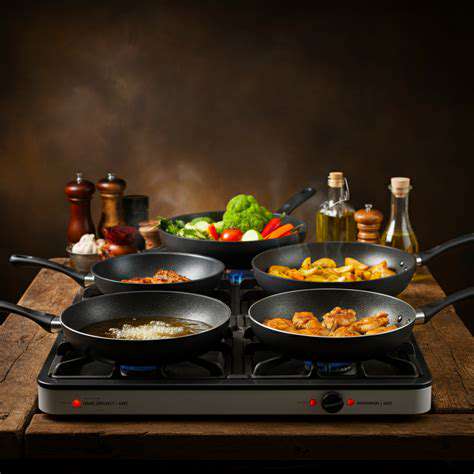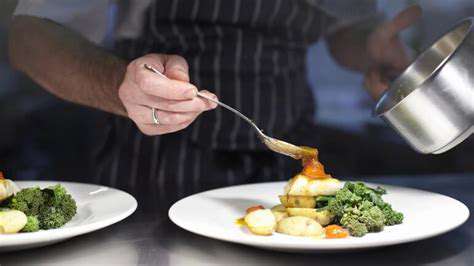Hand Techniques in Culinary Arts
Understanding the Fundamentals
Knife skills go beyond mere technique—they form the bedrock of culinary artistry. A chef's ability to handle a knife with precision transforms raw ingredients into culinary masterpieces. Proper grip, stance, and blade alignment are non-negotiable for both safety and performance. When mastered, these elements allow for seamless slicing, dicing, and mincing, yielding uniform results that elevate any dish.
Grip and Stance: The Cornerstones of Control
Control begins with how you hold your knife. A firm yet relaxed grip prevents slippage while maximizing efficiency. Your stance matters just as much: feet shoulder-width apart, body centered over the cutting board. This foundation ensures stability, allowing for fluid, controlled movements. Remember—precision isn't just about sharp blades; it's about how your entire body works in harmony.
Consistency in pressure and motion directly impacts your results. Uneven cuts can ruin a dish's texture and presentation, while uniform pieces cook evenly and look professional.
Essential Cuts: From Chopping to Mincing
Every cut has purpose. Whether you're rough-chopping herbs for pesto or creating perfect brunoise for garnishes, technique dictates outcome. The difference between a rustic chop and a precision dice can define a dish's character. Larger cuts like batons work well for roasting, while fine julienne adds elegance to salads.
Consider the classic dice: uniform cubes ensure even cooking, whether you're preparing mirepoix or potatoes. Size variations (from tiny 1/8 brunoise to 3/4 large dice) serve different culinary purposes—knowing when to use each separates amateurs from professionals.
Safety First: Preventing Knife Injuries
A sharp knife is safer than a dull one. This counterintuitive truth stems from how dull blades require more force, increasing slip risk. Always:- Secure your cutting board with a damp towel underneath- Keep fingers curled inward using the claw grip- Maintain a clear workspace free of distractions- Store knives properly—never loose in drawers
Rushing leads to accidents. Instead, focus on methodical movements. If you drop a knife, never try to catch it—step back and let it fall.
Practice and Refinement: Mastering the Art
Like any skill, knife work improves with deliberate practice. Start by practicing basic cuts with inexpensive vegetables—onions and carrots are ideal. Time yourself chopping a cup of onions, then work to reduce that time while maintaining precision. Professional chefs spend years refining these skills; don't expect overnight mastery.
Consider taking a class or watching expert chefs. Notice how they position their guiding hand and how the knife glides through ingredients. These subtle nuances make all the difference.
The Art of Sauteing and Stir-Frying: Mastering Heat and Technique

Mastering the Pan: Essential Techniques for Sautéing
Sautéing is culinary alchemy—transforming ingredients through precise heat application. The pan's temperature makes or breaks your dish. Listen for the sizzle when food hits the oil; that audible cue confirms proper heat. Too quiet means steaming, while smoking indicates dangerous overheating.
Pan selection matters:- Cast iron retains heat for perfect searing- Stainless steel allows for fond development- Non-stick works best for delicate items like fishAlways preheat your pan before adding oil—this prevents sticking and ensures even cooking.
Selecting the Right Oil: A Culinary Choice
Oil selection is both science and art. Consider:- Smoke point (avocado oil: 520°F vs. butter: 350°F)- Flavor profile (peanut oil for Asian dishes, olive oil for Mediterranean)- Health factors (monounsaturated fats in olive oil vs. saturated fats in coconut oil)
For high-heat stir-frying, refined oils like safflower or grapeseed outperform extra virgin olive oil. Reserve flavorful oils like walnut or sesame for finishing touches.
Preparing Your Ingredients: A Foundation for Success
Consistent sizing isn't just aesthetic—it's practical. Vegetables cut to equal size cook at the same rate. For stir-fries:- Cut dense vegetables (carrots) smaller than quick-cooking ones (zucchini)- Pat proteins dry for better browning- Have all ingredients prepped before heating the pan—stir-frying waits for no one
Controlling Heat and Timing: The Art of Precision
Master the two-zone approach: one side of the pan hotter for searing, the other cooler for finishing. This technique prevents overcooking while developing flavor. For proteins:1. Sear on high heat to develop crust2. Move to cooler zone to finish cooking through3. Rest before slicing to retain juices
The Stir-Fry Technique: A Dance with the Pan
Stir-frying is about constant motion. Use a wok spatula to:- Toss ingredients upward to prevent burning- Push cooked items up the wok's sides- Keep raw ingredients in contact with the hottest zoneThe distinctive wok hei (breath of the wok) comes from this dynamic cooking method.
Flavor Enhancers and Seasonings: Elevating Your Dishes
Layer flavors strategically:1. Aromatics (garlic, ginger) first—briefly to avoid burning2. Proteins next for surface browning3. Vegetables by cooking time4. Sauces last to prevent scorchingA splash of rice wine or vinegar at the end brightens the entire dish.
Beyond the Basics: Creative Applications
Reimagine traditional techniques:- Sauté fruits for dessert compotes- Stir-fry lettuces like romaine for warm salads- Use the method for grain dishes like quinoa pilafInnovation happens when you apply fundamentals in unexpected ways.
Hand Techniques in Presentation: Enhancing the Culinary Experience

Crafting a Compelling Hand Gesture
Effective hand communication bridges the gap between chef and diner. Purposeful gestures direct attention to a dish's highlights—the crisp sear on a scallop or the delicate garnish placement. Consider:- Open palms when describing preparation methods- Precise pointing to highlight specific ingredients- Fluid motions mimicking cooking techniques
Cultural awareness matters: In some traditions, pointing directly at food is impolite. Adapt your gestures to your audience's expectations while maintaining authenticity.
Managing Hand Posture for Impact
Your hands tell a story before you speak. Avoid:- Clenched fists (suggests tension)- Hidden hands (implies uncertainty)- Fidgeting (distracts from your message)
Instead:- Rest hands lightly on the table when not gesturing- Keep movements within the power zone (between waist and shoulders)- Use mirror practice to eliminate unconscious habits
Remember: In plating demonstrations, every finger movement becomes part of the culinary theater. Glove selection (black for contrast, white for cleanliness) can further enhance visual communication.
Read more about Hand Techniques in Culinary Arts
Hot Recommendations
- The Impact of the Digital Age on Hand Function
- The Role of Hands in Agricultural Innovation
- The Impact of Technology on Hand Artistry
- The Importance of Hand Care for Artists
- How Hand Control Enhances Robotic Surgery
- The Impact of Hand Strength on Physical Labor
- How Handwriting Influences Cognitive Development
- The Impact of Environmental Factors on Hand Health
- The Power of Hands in Building Community
- The Importance of Ergonomics in Hand Health











